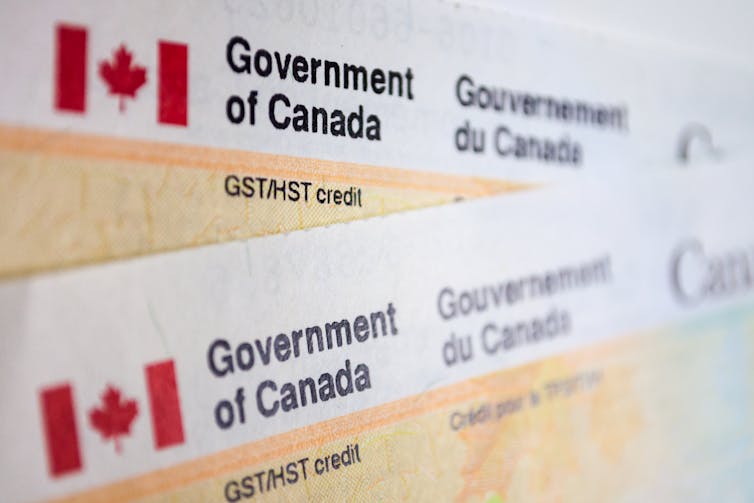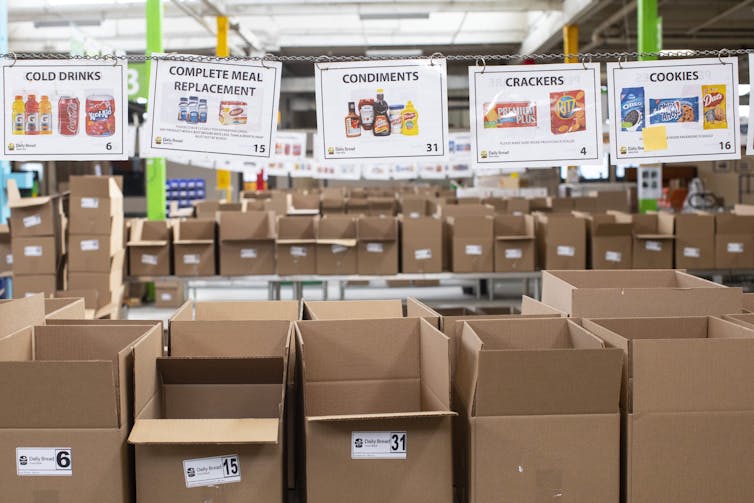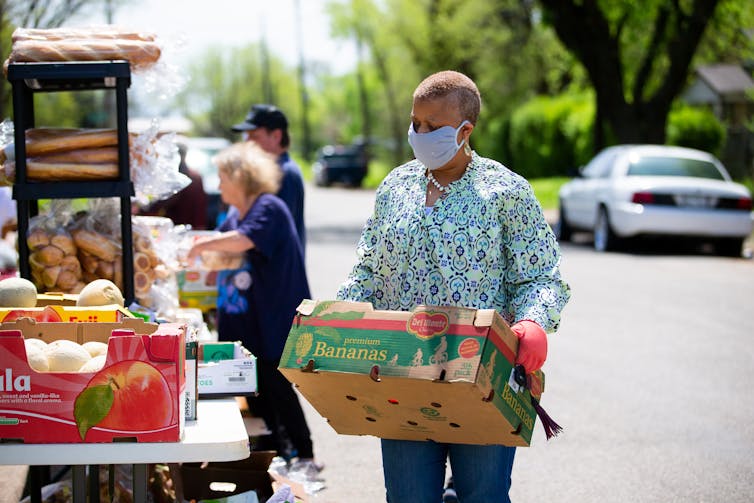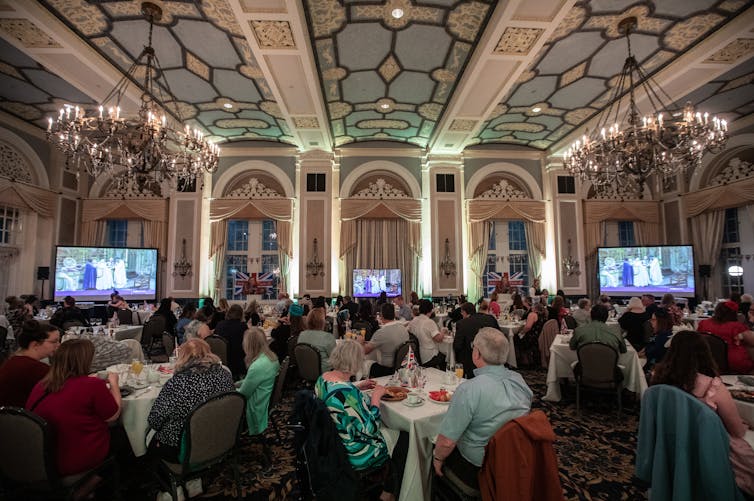
USA & CANADA (849)
Latest News
Why a Toronto high school principal’s death is wrongly linked to anti-racist training
Thursday, 10 August 2023 03:54 Written by THECONVERSATION 
Nicole Bernhardt, University of Toronto
Last month, a former Toronto school principal, Richard Bilkszto, died by suicide. Although the reasons for suicide are complex, his family and lawyer released a statement linking his death to an anti-racism workshop he had attended.
Those ardently opposed to “woke politics” are now using Bilkszto’s tragic death to decry anti-racism and equity work. The Ontario Ministry of Education, led by Stephen Lecce, has called the allegations “serious and disturbing” and plans to conduct a review of how anti-racism and equity work is done at school boards.
The workshop Bilkszto attended was led by Kike Ojo-Thompson, CEO of the KOJO Institute. Ojo-Thompson has called the death of Bilkszto a tragedy. Ojo-Thompson was unaware that earlier this year, Bilkszto had filed a lawsuit against the school board concerning the anti-racism workshop she led about white supremacy.
As someone who has worked in the fields of equity, education and anti-racism, I understand both the importance and the burden of naming “racism” and “white supremacy” within institutions. It is crucial to support those who risk their reputations and livelihoods to do this naming.
I see the current media storm as a precedent-setting moment on the risks associated with institutional equity work. I believe it will also test Canadians’ commitment to doing the work needed to address racism.
The minister’s response as well as those by right-wing news media have helped to fuel a narrative that anti-racism and equity work is to blame.
Anti-racism training denigrated by news media
The Daily Mail described the investigation into Bilkszto’s death as one that will look into “whether the obsession with woke policies may have contributed” to his death.
The National Post wrote: “It’s no coincidence that Bilkszto came out humiliated” since “the DEI industry is designed to sell guilt and shame and perpetuate a culture of victimhood.”
The Toronto Sun has suggested there is need to look at “the general issue of diversity, equity and inclusion training” concluding “reform may be sorely needed.”
Equity work disrupts ‘safe spaces’
Equity training aims to address practices that sustain institutional inequities. It begins with the acknowledgement of both historical and contemporary inequities and the premise that such work is needed to bring about equity.
Even at its mildest, equity work involves taking some people outside of their comfort zone. But equity work at its most meaningful involves getting people to recognize that their comfort zone has depended on other people’s silence and marginalization.

Yet equity work is often conducted within the context of a market-based relationship, where client priorities dictate the boundaries of change and disruptiveness. These boundaries are frequently constructed around language choices — with terms like “diversity” and “inclusion” being permissible while, “racism” is deemed too polarizing.
When wading into discussions about equity and racism, the practice of establishing guidelines has been a central strategy for mitigating the associated risks. This practice has often been described as building a “safe space.” But long-time social justice educators, Brian Arao and Kristi Clemens, argue “that authentic learning about social justice often requires the very qualities of risk, difficulty and controversy that are defined as incompatible with safety.” This is especially the case when these conversations are taking place within the very institutions that are being asked to confront their own racist and inequitable practices.
Safety also gets conflated with comfort when people expect these conversations not to be upsetting or difficult, or expect not to be held accountable for their comments. This is an impossible standard to set for conversations that challenge institutional norms and social inequities.
McGill University political scientists Tari Ajadi and Debra Thompson describe this type of racism as “simultaneously individualistic and systemic.” Discussing racist systems requires reference to tangible individual instances of racism to illustrate how racism is reproduced.
Sometimes this is met with tears and sometimes this is met with defensiveness. For example, in a training I once conducted, a white woman cried when she realized that she had been using language to describe Black children which I explained reiterates racialized stereotypes that harm and dehumanize Black people.
Even when we try to make intentional language choices, such as “address the comment, not the speaker,” the illustration of racism will feel personal for those whose behaviour is implicated.
In her column for the Toronto Star, journalist Shree Paradkar, carefully delineated between the ideas of “upholding white supremacy” and “calling someone a white supremacist” in her review of Ojo-Thompson’s words in the session recordings. But this delineation fails to satisfy those avowedly anti-woke commentators for whom the language of racism and white supremacy is always considered unspeakable.
The unspeakability of racism
Following the 2020 “summer of racial reckoning,” almost every sector in Canada was compelled to initiate equity work. Many developed Equity, Diversity & Inclusion (EDI) policies, and several demonstrated a willingness to have difficult conversations on racism.
Since then, the perceived urgency of this equity work has been steadily waning, yet the resistance to this work has remained forceful.
Equity studies scholar Sheila Dawn Gill offered the term “unspeakability of racism” to describe the barriers to naming racism within Canadian spaces. She used the example of the silencing of the late Cree politician, Oscar Lathlin, for using the term “racist.” This silencing was again applied to current NDP Leader Jagmeet Singh’s use of “unparliamentary language.”
Broad acceptance of the reality of systemic racism is meaningless if it cannot be applied towards understanding how racism is enacted both individually and institutionally through comments, actions and specific circumstances. Institutional commitments to anti-racism are meaningless if they do not extend support and care to those doing this work.
Two decades ago, Canadian political scientist Malinda Smith described how the “race manners” of Canada continue to support the suppression of the naming of racism and obscure the way that race continues to matter throughout Canadian institutions.
The vilification of Ojo-Thompson for talking about white supremacy demonstrates the enduring hold of Canada’s race manners, even in the wake of our collective racial reckoning.
If you are experiencing suicidal thoughts, you need to know you’re not alone. If your life or someone else’s is in danger, call 911 for emergency services. Or, call Talk Suicide Canada at 1-833-456-4566.![]()
Nicole Bernhardt, Assistant Professor, Political Science, University of Toronto
This article is republished from The Conversation under a Creative Commons license. Read the original article.
US laws to promote home-grown industries will hurt African economies
Thursday, 06 July 2023 22:43 Written by THECONVERSATION 
Jonathan Munemo, Salisbury University
The Biden administration has ratcheted up protectionism and industrial policy amid surging economic tensions with China. Legislation passed in 2022 unlocked hundreds of billions of dollars in subsidies to spur domestic production of renewable energy and electric vehicles, and to support other decarbonisation goals.
The legislation is also designed to support homegrown strategic industries such as high-end semiconductors while constraining China’s access to such technologies.
Having watched global trade patterns since the second world war, I’m concerned that we are now entering a new and more dangerous period. Washington’s protectionist industrial policy started with the US-China trade war under the Trump administration. It is exacerbating economic fragmentation of the global economy fuelled by the war in Ukraine and economic sanctions imposed on Russia. It is doing so by fracturing trade and investment flows based on geopolitical considerations. As a result, global economic integration is being reversed. Over the past three decades, global economic integration raised productivity growth, lifted living standards and reduced extreme poverty.
We can see this happening as US allies respond with inward looking protection measures of their own and align with the US to create a global supply chain less reliant on China. Cases in point are the EU, Japan and Korea.
This could have far-reaching negative consequences for countries in Africa. Some will be hit harder than others. For example the 19 African countries facing debt distress have scarcer fiscal resources to manage costs of the fallout. But nearly all will feel the impact of higher inflation due to reduced global output in a less productive world. Many will also feel the impact of a brake on regional integration efforts as importers lose ready access to competitively priced inputs needed for value addition. And fragmentation of investment flows could restrict access to investment.
This would have adverse impacts on growth and plans to boost green investments on the continent.
US moves on protection and industrial policy
Last year, the US Congress approved the Chips and Science Act and the Inflation Reduction Act . They offer hundreds of billions of dollars in funding to encourage domestic production of chips and clean energy technologies. They are also aimed at barring exports of high-end semiconductors and equipment to China, and pushing allies to do the same.
These acts, together with the infrastructure bill Biden signed in 2021 to boost iron and steel made in the US with more federal spending, have combined to shape America’s current protectionist industrial strategy.
This has unsettled policy makers in Europe and Asia, where the laws are seen as unfairly benefiting American companies and moving away from free trade. They have also sparked worries that companies and investment from their regions will be lured to the US. Those worries foreshadowed German-based Volkswagen AG’s move in March to build a $2 billion car factory for a new electric brand in South Carolina.
Also, Swedish battery maker Northvolt AB has stated that expansion into the US market is now among its top priorities. For its part, Samsung intends to use chip subsidies for an advanced plant it’s building in Texas.
Unnerved by these moves, the EU has responded with its own massive subsidy plans to support businesses paving the way to a low-carbon economy. It also passed a Chips Act in April to support semiconductor manufacturing within the region with billions of dollars in subsidies.
Other US allies are following suit. Japan’s government has negotiated a deal with Washington that allows critical minerals shipped from its companies to qualify for US subsidies.
The EU is also interested in securing a similar deal. South Korea plans to spend hundreds of billions of dollars for investments in chips, batteries, electric vehicles and other green technologies.
The US-led subsidy push and export controls are fragmenting the global economy by redirecting supply chains from China. They are also alienating non-EU and Asian allies that can’t support their companies with similar subsidies.
African countries will be hit hard
These shifts will ultimately reduce gains that have been made in increasing integration of international goods and investment markets. These have included higher global output growth, the opportunity to take advantage of new technologies and lower costs for businesses and consumers.
This means that countries with larger economies like Nigeria, South Africa, Ethiopia and Kenya which demand more imports are likely to be hit harder by rising domestic costs and higher international prices of imported goods. These will both feed into higher inflation, to the detriment of businesses and households.
In another blow, regional trade integration efforts including expansion of the digital economy, infrastructure improvements, enhanced regional trade logistics and delivery of financial services will be affected by the higher cost of intermediate inputs and lack of access to new technologies. Both are critical for building regional value chains and diversifying production.
Also, companies in most African countries will lose out because they don’t have the backing of deep-pocketed governments able to provide huge subsidies and other incentives to exploit green investment opportunities on a scale that comes close to that of the US and its rich allies.
The International Monetary Fund has flagged that the continent stands to lose the most from global economic fragmentation. In a recent assessment it said that the cost to the median African country could be as high as 4% of GDP.
Mitigating measures
The US Strategy Towards Sub-Saharan Africa unveiled by the Biden administration last year seems to be the ideal platform to address concerns about America’s protectionist industrial policy. That’s because its key objectives include helping Africa navigate the energy transition and enhancing US trade and investment with the continent.
On the basis of this strategy, Washington and African policy makers should prioritise the following:
Forge public-private partnerships for the production and domestic processing of minerals that are key ingredients for the green energy transition. These include nickel in Tanzania, palladium and manganese in South Africa, copper in Zambia, cobalt in Congo and lithium in Zimbabwe.
Promote investments to build strong regional supply chains. This should include enabling Africa to take advantage of technologies like digitalisation, which can boost trade through e-commerce.
Capitalise on any positive effects to drive growth and diversification of trade with Africa under the African Growth and Opportunity Act.

Jonathan Munemo, Professor of Economics, Salisbury University
This article is republished from The Conversation under a Creative Commons license. Read the original article.
Wildfire preparedness and response must include planning for unhoused people and other vulnerable populations
Wednesday, 07 June 2023 09:49 Written by THECONVERSATIONThe 2023 Canadian wildfire season is off to a roaring start. In Alberta, there have been more than 560 wildfires so far — the highest recorded number of fires since 2018, and the season has only just begun. Tens of thousands of residents have been evacuated and a state of emergency was declared across the province.
Wildfires are not new to the region. The 2016 Horse River/Fort McMurray Wildfire was the worst wildfire and most costly disaster in recent Canadian history. Meanwhile, on the opposite side of the country, Nova Scotia has already experienced a historic 200 wildfires, resulting in a local state of emergency in Halifax Regional Municipality and more than 25,000 displaced residents.
As public health and disaster management scholars, our research focuses on how best to support the health of vulnerable populations in adverse situations, including through disasters, political challenges and geographic isolation. We have been devastated watching news coverage of the recent wildfires, including in one of our home provinces. However, we are not shocked.
With the impacts of climate change, wildfires in Canada will continue to intensify in strength and frequency. Enclosed shelter is paramount in reducing exposure to wildfire smoke. Yet, what happens to the nearly 35,000 unhoused Canadians on any given night who cannot easily evacuate or shelter indoors?
Impact on the unhoused
Research suggests that unhoused people are most vulnerable in disasters as they are often the first to experience them and often do not have the ability to prepare or alleviate their risks. In particular, studies show unhoused people’s disproportionate risks to health during heat events and wildfire due to limited access to appropriate shelter.
Many unhoused people have pre-existing health issues that can be worsened during disasters. These include substance use disorder, mental illness and chronic conditions. For people with a substance use disorder, there can be significant disruptions to accessing treatment medications and inequities in opioid-related deaths in communities vulnerable to disasters.
Even for unhoused people outside of evacuated communities, poor air quality caused by wildfire smoke can cause heat stroke, dehydration and respiratory illness.
Despite these unique harms, unhoused people have limited access to resources and supports that facilitate evacuation and post-disaster recovery. Both Alberta and Nova Scotia have relied on the use of emergency alerts, yet many unhoused people do not have access to technology for emergency alerts and are not eligible for disaster relief support.
Evacuation centres are open to all, yet stigma and mistrust of authorities can prevent access for the unhoused. Furthermore, research shows that authorities tend to provide more support for those who have lost their housing due to wildfires than those who were previously unhoused.
Planning for unique risks
As many Canadian provinces are currently experiencing, extreme heat and wildfires are increasing in frequency and intensity.
Loss of housing and infrastructure compounds an already fragile housing environment, especially for renters and Indigenous populations. A lack of affordable housing, aggravated by disasters, further reduces the likelihood that people living precariously will secure permanent housing, which would better protect them during future wildfire seasons.
Although cooling centres open during extreme heat, there are few respite centres during periods of low air quality, particularly in the evening. Looking at other provinces, Housing BC and End Homelessness Winnipeg are working towards ensuring unhoused people are supported during extreme heat and wildfire smoke. However it is unclear how unhoused populations are being helped during the current wildfires.
Our concern as researchers is that there is an alarming lack of international, national and provincial plans or guidelines that consider the unique risks and needs of unhoused populations during wildfires.
What is apparent is that response often falls on service providers who support the unhoused, despite adequate housing being an international human right that should be the responsibility of the government.
Support during disasters
It is imperative for all levels of the Canadian government to consider how to best support unhoused people during disasters.
Looking at international responses to other disasters, promising practices include trauma-informed and addictions/mental health training for emergency responders and evacuation personnel, outreach services, developing inclusive materials for preparedness and response (for example, flyers and handouts), providing inclusive low-barrier evacuation spaces, and dedicating resources to post-disaster recovery and support for the unhoused.
Most importantly, any response must involve a co-ordinated partnership between community organizations, the government and those with the experience of being unhoused.
We need to better prepare for Canada’s wildfire season by including high risk and extremely marginalized populations, such as those who are unhoused, in emergency management plans and practices. Greater consideration of high-risk populations will ensure no one gets left behind.![]()
Holly Mathias, PhD student, School of Public Health, University of Alberta and Ashleigh Rushton, Postdoctoral Fellow, Health Sciences, University of The Fraser Valley
This article is republished from The Conversation under a Creative Commons license. Read the original article.
As the U.S. expands work conditions for income assistance, Canada takes a different tack
Wednesday, 07 June 2023 09:46 Written by THECONVERSATION 
Wayne Simpson, University of Manitoba
Only days before a government default, United States President Joe Biden and House Speaker Kevin McCarthy reached an agreement to raise the country’s debt ceiling and avoid financial turmoil.
One important feature of this agreement is an expansion of the work requirements for recipients of Medicaid and food stamps. These new work conditions could affect millions of low-income Americans.
The expansion would limit childless able-bodied adults between 18 and 55 to only three months of assistance every three years unless they meet certain work-related criteria, like working at least 20 hours a week.
But while attaching work conditions to social assistance has been the norm for U.S. federal income assistance for a very long time, this hasn’t always been the case.
U.S. work conditions for assistance
The U.S. War on Poverty provided the impetus for former president Richard Nixon to propose the Family Assistance Plan in 1969 to alleviate poverty and welfare dependence.
The plan involved a negative income tax that would have provided $500 per adult and $300 per child — regardless of work conditions — to families without other income.
Legislation was passed with bipartisan support in 1970, but encountered opposition in the Senate because of concerns about work disincentives and welfare dependency. These concerns could not be alleviated by preliminary evidence of an insignificant work response in the New Jersey Income Maintenance Experiment.

The Family Assistance Plan was eventually replaced with the Earned Income Tax Credit, which only provides assistance by topping up the earnings of low-income Americans. It effectively attaches work conditions to federal income assistance.
The Earned Income Credit has grown in popularity through successive U.S. administrations with enhanced benefits, expanded coverage and advanced regular payments.
As the major program of cash support for low-income families, it works in concert with the federal food stamps program administered by states according to requirements and funding.
It’s therefore unsurprising that moves to tighten requirements for food stamps and Medicaid would rely on more stringent work conditions.
Canada’s alternative approach
While work conditions have long been the norm for U.S. federal support programs, Canada has taken a different path. Even before Nixon’s Family Assistance Plan, Canada had instituted the Guaranteed Income Supplement for seniors in 1967.
Like the Family Assistance Plan, it was designed as a negative income tax to supplement the Old Age Security benefits for low-income seniors.
The minister of national health and welfare at the time, Allan MacEachern, introduced the measure as a “simple, acceptable and effective” guaranteed income.
While work conditions were of little concern for the senior population, MacEachern noted the supplement could encourage work for those who sought it.
The supplement expanded over time and contributed to reducing seniors’ poverty in Canada to rates that were among the lowest in the world.
The federal sales tax refundable credit followed in 1986. It remains modest, but has been boosted recently to assist low-income families in the inflationary aftermath of the pandemic.
More substantial is the refundable child tax credit, introduced as a modest benefit in 1978 but expanded to the modern Canada Child Benefit in 2016. It lifted a significant number of families with children out of poverty almost immediately.
The common thread in the construction of this federal income support network has been the absence of work conditions. An American-style earned income tax credit was introduced in 2008, but it remains modest.
Recent research exploring the potential expansion of this credit as a replacement for social assistance and most other existing tax credits showed that it would reduce poverty for families and working-age singles. However, it would have significantly less overall poverty impact than similarly priced guaranteed income models that don’t have work conditions.
Are work conditions needed?
Work conditions have been at the heart of opposition to income support policies for a very long time. Concerns that a negative income tax would discourage recipients from working was front and centre in the design, conduct and analysis of guaranteed basic income experiments in the U.S. and Canada in the 1970s.
The experiments provided evidence of modest discouragement towards work, and subsequent basic income pilot projects and other similar studies have not changed this perspective. For example, there is no evidence of an adverse work response to the Canada Child Benefit.

But despite this evidence, work conditions remain a sticking point for federal aid in the U.S. — not only among Republicans, but among swing-vote Democrats and the public at large. This suggests federal aid work conditions will remain in place in the U.S.
By their very nature, work conditions likely provide some encouragement to low-income families to find employment to qualify for benefits. The U.S. Earned Income Tax Credit slightly improves female labour force participation.
By design, however, federal programs with work conditions attached are unlikely to improve deep poverty.
Work conditions remain for welfare
The distinction between the U.S. and Canada’s approaches don’t extend beyond federal income assistance. Work conditions and other bureaucratic measures still dominate at the state and provincial level, despite significant federal funding support.
Temporary Assistance for Needy Families in the U.S. strengthened requirements for job searching and work-like activities, despite evidence that bureaucratic measures already in place reduced welfare participation.
In Canada, provinces still employ a complex bureaucratic machinery to receive claims, assess eligibility, deliver benefits, impose work conditions, police fraud and non-compliance, determine and recover over-payments, provide social services and report to authorities.
While there is little impetus to remove work conditions and other bureaucratic controls in the U.S., there is some movement to reduce barriers to welfare participation in Canada.
Most notably, the Prince Edward Island legislature has affirmed their support for a basic income to replace current welfare assistance in the province. This would separate receipt of welfare benefits from employment services and other work conditions imposed elsewhere.![]()
Wayne Simpson, Professor, Department of Economics, University of Manitoba
This article is republished from The Conversation under a Creative Commons license. Read the original article.
Popular News
President Joe Biden, 80, takes a tumble on the stage during Air Force Academy graduation (Video)
Sunday, 04 June 2023 01:27 Written by lindaikeji US President Joe Biden, 80, took a tumble on the stage during Air Force Academy graduation on Thursday, June 1. Afterwards, he sat back down and appeared to be fine. White House communications director Ben LaBolt later explained on Twitter that the mishap occurred because there was a sandbag on the stage.
The fall happened during the U.S. Air Force Academy graduation ceremony in Colorado Springs, where Biden delivered the commencement address. Biden was helped back up and pointed out that he had tripped over something.
'%20class='img-responsive%20text-center'%20style='margin:%20auto;'/img%20alt='President%20Joe%20Biden,%2080,%20%20takes%20a%20tumble%20on%20the%20stage%20during%20Air%20Force%20Academy%20graduation%20(Video)'%20class='img-responsive%20text-center'%20style='margin:%20auto;'/2023/06/02/550x309/Screenshot_2023-06-02_073527_1685671536156_1685671566251.png)


As governments shirk their responsibilities, non-profits are more important than ever
Wednesday, 31 May 2023 08:08 Written by theconversation 
Kevin Gosine, Brock University; Darlene Ciuffetelli Parker, Brock University, and Tiffany L. Gallagher, Brock University
You’ve likely walked past that non-profit youth centre or literacy program in your neighborhood countless times. You’ve probably never needed to make use of it and never given it a second thought.
But on your next stroll, take a moment to consider the work that organization does, the challenges it faces and the vast benefits it brings to your community.
In an age of proliferating social troubles and government retreat, Canadians must be aware of the critical role played by the non-profit sector.
Recent decades have seen the welfare state withdraw in favour of free-market principles. In a neoliberal era, where profitability is prioritized over social duty, all orders of government in Canada have shirked much of the responsibility for providing social services onto non-profits.
Importance of social connections
As non-profits have become saddled with more obligations, they are handcuffed by limited funding. Long-term funding arrangements between governments and non-profits have been replaced by provisional and competitive funding. While non-profits are expected to do significantly more, they are relegated to coping with far fewer resources.
This has serious implications for the long-term well-being of communities, especially those already marginalized and under-served.
Not only are non-profits now providing critical services and social supports for which the state previously took responsibility, they are also settings where vital forms of social capital are produced.
Social capital refers to networks of trust, belonging and support developed among people within a given community (bonding social capital), and between people who identify with different communities or social groups (bridging social capital). Social capital enables people to work together toward mutual well-being and goal attainment.

Social capital doesn’t just happen
Communities must find ways to create worthwhile forms of social capital. And that’s where non-profit organizations can fill a gap. However, constantly scrambling for money leaves these organizations little time, resources and capacity to provide programming that fosters social capital.
Our research on community literacy organizations illuminated the role of non-profit organizations in helping people cultivate social capital. We conducted interviews and focus groups with program leads, staff and service users at eight non-profit organizations in southern Ontario to learn how they support literacy in their communities.
We found that producing social capital enabled them to serve communities in ways that transcended their primary mandates.
It is unrealistic to expect people to build social capital on their own, devoid of enabling social infrastructure. The challenge of creating meaningful social connections is daunting. Especially as society becomes increasingly individualistic. Religion — once a stalwart source of community — continues to decline and technology is rapidly displacing face-to-face human interaction. Urban planners and community stakeholders need to provide the settings and opportunities for people to come together, connect and collaborate.
We found that non-profit community programs serve as settings where people from marginalized backgrounds can build beneficial forms of social capital. Such local initiatives provided individuals with recurrent and predictable channels to interact, share lived experiences and work together.
For example, mothers of children with disabilities participated in self-help groups where they shared their experiences, exchanged information and generally supported one another. Civic projects, such as a community garden started at one organization, brought together residents, young and old.
Non-profit programs provide people with opportunities to interact with different community members and forge meaningful interactions with people outside their social group that mitigate prejudice and foster trust and understanding.

Over the course of our research, we saw what started as bridging social capital strengthen into bonding ties between program participants, and in many cases between program users, staff and volunteers. The significance of these bonds was powerfully conveyed by one participant who took part in our study:
… what I take away from this group [is] that there are good people still left in a world that’s so scary, and people that are there to support. And whether I’m here or not, they’re always willing to help somebody else that’s in need. And… knowing that the option of … being there and the people that come together for this group–it’s really incredible to know that you have somebody.
The programs we studied connected individuals to new people, organizations, supports and resources and provided ongoing opportunities to build bridging social capital.
While the primary purpose of the non-profit organizations was to improve literacy, these programs accomplished much more. By providing a judgement-free safe space where participants had opportunities to share and collaborate, these organizations fostered social capital within communities.
The community organizations we studied had recently lost their primary funding provided by a regional anti-poverty program. Program leads and staff remained committed to supporting service users but struggled to do so given the need to devote more time and resources to addressing funding insecurities.
Benefits of social capital
When social capital is actively fostered, social trust is elevated. Research has demonstrated that the more non-profit organizations there are in a community, the lower the crime rate. Non-profit organizations help to lessen crime by enhancing levels of social capital and trust and expanding opportunities and hope.
Strengthening people’s social and organizational ties broadens their horizons and improves their well-being. Non-profits play a crucial role in fostering and sustaining such social capital.
If governments expect communities to be viable and fend for themselves amid diminishing public support, local non-profits cannot be relegated to financial precarity. By starving the non-profit sector, governments are ironically undermining the capacity of communities to live up to the neoliberal ideals of self-reliance and local resourcefulness.![]()
Kevin Gosine, Associate Professor, Department of Sociology, Brock University; Darlene Ciuffetelli Parker, Professor, Department of Educational Studies; Director, Teacher Education, Brock University, and Tiffany L. Gallagher, Professor, Department of Educational Studies and Director, Brock Learning Lab, Brock University
This article is republished from The Conversation under a Creative Commons license. Read the original article.
Dismay over King Charles’s coronation raises questions about Canada’s ties to the monarchy
Monday, 15 May 2023 04:45 Written by theconversation 
Jeffrey B. Meyers, Kwantlen Polytechnic University
The coronation of King Charles was a cringe-inducing display of white European hereditary privilege and ostentation that angered many, both in the United Kingdom and the Commonwealth.
That anger, or in some cases simple apathy or collective eye-rolling, should not be ignored because the monarchy and the Crown are not merely symbols, they’re a massive expense.
The cost of the coronation to the British taxpayer has been estimated at £100 million (almost $170 million in Canadian dollars) — extremely costly in a post-Brexit period of economic uncertainty and decline for the U.K..
Some of the vast private wealth and land holdings of the Royal Family are also connected directly to England’s role in colonization and the slave trade.
Despite all this, the monarch remains the head of state for many Commonwealth countries, including Canada.

The U.S. style of republicanism
While the American experiment in republicanism isn’t looking especially good at the moment amid the shambles left by Donald Trump’s presidency, the country’s founders were correct in recognizing that democratic legitimacy and monarchical power cannot be easily reconciled.
In fact, their biggest mistake and that of subsequent generations may simply have been to permit the presidency to retain elements of absolute or unfettered power in the form of executive privilege.
From George W. Bush’s disastrous war on terror to the Trump administration’s outright repudiation of democratic norms, recent presidents have not hesitated to behave like kings.
In Canada, we can benefit from both the lessons of the United States and the U.K. to avoid idealizing a republic with a powerful president and at the same time acknowledging that a traditional monarchy, even a purely symbolic or constitutional monarchy, is no alternative.
As I have argued before, each Commonwealth nation would have different legislative and constitutional processes to follow to sever ties with the British monarchy. Canada’s in particular would be complex and difficult, but not necessarily impossible.
It would require unanimous consent of all provincial legislatures and the federal Parliament. In practice, this would probably not be possible without referendums in each province. Because of this, some leading constitutional lawyers in Canada regard the question as a non-starter.
But if Canadians aren’t careful, they may one day find that events in the U.K. make the decision for us.
Here’s how.
Different political systems
Suppose current British demographic trends and polling data pan out and a decade or two from now a younger, more diverse British population loses patience with the monarchy.
Like Canada, the U.K. has a constitution and the monarchy is essential to it. But unlike Canada, the U.K.’s constitution is largely unwritten. Changing the British Constitution can at least theoretically be done by an ordinary act of Parliament and without the complexity of co-ordinating 10 sovereign legislatures.
Another difference? The U.K. is a unitary and not a federal state. This means British parliament, unlike Canada’s, can unilaterally amend its constitution to address the status of the monarchy if it wishes.
Similarly in the U.K., any conventions around public consultation would also be arguably less complex and more straightforward than in Canada because of the British system of government. This could lead to a bizarre situation in which the British monarch ceases to be the British head of state but remains the Canadian one.
To my knowledge, this would be a completely uncharted territory and a constitutional crisis of the highest magnitude.
Rather than continuing to sit nervously on the sidelines observing America’s presidential system lurch from crisis to crisis, or celebrating the coronation of Britain’s new king as our own, Canada should learn from the errors of both the republican model and monarchical model and do something different.

Looking ahead
We might start by recognizing forms of political association, governance and policymaking that are less European and owe more to Indigenous models.
Mary Simon, Canada’s governor general and the King’s representative in Canada — as well as first Indigenous person to occupy that colonial office — is correct when she says many Indigenous people look to the treaty relationship with the Crown, which predates Confederation itself, as part of their strategy of decolonization.
But it’s tough to reconcile a European hereditary monarchy with a Canada in which Indigenous people are attempting to take control over their own destiny.
Similarly, for many Canadians who immigrated to Canada from parts of the former British Empire in the Caribbean, Africa and India, finding the old colonial monarchy waiting for them here is no sign of dynamism.
It will be up to the current generation of Canadians to decide if now is the time to begin taking this question more seriously or whether to leave it to the United Kingdom to decide for us.![]()
Jeffrey B. Meyers, Instructor, Legal Studies and Criminology, Kwantlen Polytechnic University
This article is republished from The Conversation under a Creative Commons license. Read the original article.
King Charles III’s coronation oath is a crucial part of the ceremony – experts explain
Saturday, 06 May 2023 08:14 Written by theconversationThe crowning is perhaps the most famous part of British coronations. Yet easily overlooked – and equally important – is the coronation oath, which has been a fundamental component of the ceremony since medieval times.
It is of such significance that the remainder of the rite cannot proceed unless it has been sworn. Why? The oath is the essential counterpart to the recognition and acclamation.
The recognition is the moment at the beginning of the ceremony when the monarch is presented to the people for approval. The acclamation is the moment in which the people accept the new monarch.
Together, these three acts establish a contractual relationship between sovereign and peoples. By public commitment to the promises and values enshrined in the oath, the monarch is forming a bond to the largely uncodified constitution (the UK’s constitution has never been assembled into a single written document).
There has been talk of a shorter service for Charles III’s coronation. But to omit these vital stages would amount to constitutional vandalism.
Before primogeniture (the law of firstborn inheritance), the British monarchy was elective. In Anglo-Saxon times, the witan (the leading nobles or council of the country) chose the new sovereign. And until at least the middle ages, a secular enthronement, preceded the coronation service.
Today’s acclamation comes from that tradition of electing a sovereign. This is when the officiant (usually the Archbishop of Canterbury), standing with the candidate in Westminster Abbey, asks whether or not the congregation recognises the candidate’s entitlement to be crowned.

Those present acclaim the person as their monarch, crying “God save the King/Queen”, representing the country. Some historians contest the acclamation’s importance on the grounds that the respondents are unrepresentative of the people and unlikely to reject the candidate: “as if there was any choice in the matter”.
Nevertheless, it is vital to what follows that they are asked at all. In Portugal, under the Avis dynasty, the acclamation assumed such supreme importance that the crowning withered away altogether. By contrast, Russian peasants were never asked for consent to recognise a new Tsar.

This piece is part of our coverage of King Charles III’s coronation. The first coronation of a British monarch since 1953 comes at a time of reckoning for the monarchy, the royal family and the Commonwealth.
For more royal analysis, revisit our coverage of Queen Elizabeth II’s Platinum jubilee, and her death in September 2022._
Following the acclamation, the candidate must commit to their side of the contract – the terms set out in the coronation oath. “Coronation oath” is a slight misnomer. It is actually a series of promises in question and answer form, sealed by an oath sworn “in God’s presence”. The text of the promises has evolved, but the core has remained.
In the version lasting (with tweaks) from 1308 to 1685, the candidate promised to confirm the laws of their predecessors, to maintain peace, to administer impartial justice with mercy and to preserve and enforce the laws that parliament would pass.
The makings of a modern oath
The Glorious Revolution of 1688-1689 ushered in a major change when a revised oath became statutory. The version used for Queen Elizabeth II’s coronation in 1953 had three essential parts and retained the oath’s medieval core.
Firstly, would she promise: “to govern the Peoples … according to their respective laws and customs?” Secondly, would she cause: “Law and Justice, in Mercy, to be executed in all … [her] judgements?” Lastly would she: “maintain the Laws of God and the true profession of the Gospel” as well as “maintain in the United Kingdom the Protestant Reformed Religion established by law”?
Afterwards, came the oath proper. Elizabeth II swore:
The things which I have here before promised, I will perform and keep. So help me God.
As this shows, the monarch swears to uphold certain key values: law, justice and mercy (although Charles has said he sees himself as a “defender of faiths” and the service is likely to reference other denominations and religions).
That obligation speaks to the nation, but also broadcasts a global message of what the United Kingdom stands for.
The coronation oath marks the moment the monarch’s actions and words correspond to the trust placed in them by the people when they recognised and acclaimed them as their king or queen. Together, the two stages form a contract on the basis of which the service can proceed to the crowning.
There is a sense that uncrowned (and therefore unsworn) monarchs were, and are, not fully sovereign. Would Richard III have usurped the crown so easily had one of the princes in the tower been crowned? Might Lady Jane Grey (the nine-day queen) have seen off Mary Tudor if she had reigned long enough to undergo coronation? As it was, Mary I led the only successful coup d’état of the 16th century.
Writing of Edward VIII, who abdicated in 1936, the late Queen Mother commented that it was fortunate that “he was never crowned”. Clearly, an abdication post-coronation would have been more problematic because the coronation oath establishes accountability.
Breach of contract can, for a sworn monarch, have terrible consequences. The charge of flouting their coronation oaths was levelled against Edward II (deposed and murdered), Richard II (ditto), Charles I (deposed and executed) and James II (deposed and exiled). Those kings could not be trusted because they had broken their sacred word.
The oath is at once a conduit for tradition, a constitutional pillar, a source of legitimacy and authority and a marker of national values. The coronation oath binds monarch to peoples and to the governmental system of the state, but it also communicates some of the principles – law, justice and mercy – upon which that governance rests.
Oaths are still an important part of employment in the British armed services, police force, parliament, privy council and law courts. Each of those oaths mentions allegiance, service or loyalty to the sovereign. How incongruous it would be if the person at the summit of the constitutional pyramid had no oath to swear themselves.![]()
David Crankshaw, Lecturer in the History of Early Modern Christianity, King's College London and George Gross, Visiting Research Fellow, King's College London
This article is republished from The Conversation under a Creative Commons license. Read the original article.






